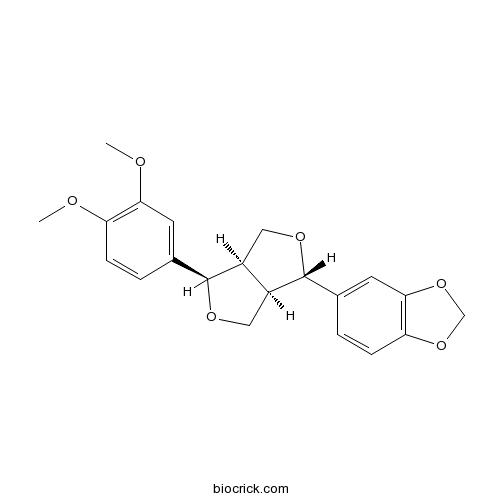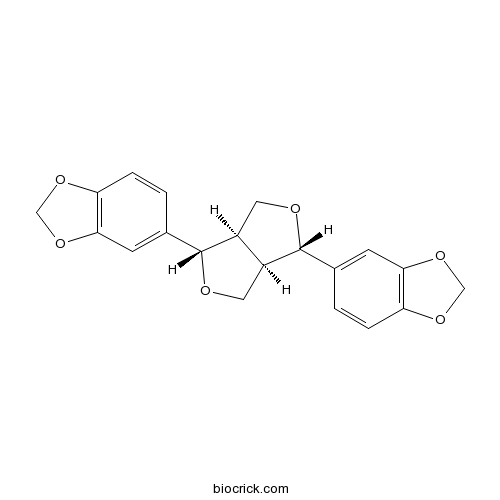Zanthoxylum simulans
Zanthoxylum simulans
1. The products in our compound library are selected from thousands of unique natural products; 2. It has the characteristics of diverse structure, diverse sources and wide coverage of activities; 3. Provide information on the activity of products from major journals, patents and research reports around the world, providing theoretical direction and research basis for further research and screening; 4. Free combination according to the type, source, target and disease of natural product; 5. The compound powder is placed in a covered tube and then discharged into a 10 x 10 cryostat; 6. Transport in ice pack or dry ice pack. Please store it at -20 °C as soon as possible after receiving the product, and use it as soon as possible after opening.
Natural products/compounds from Zanthoxylum simulans
- Cat.No. Product Name CAS Number COA
-
BCN5022
Fargesin31008-19-2
Instructions

-
BCN1273
Dictamnine484-29-7
Instructions

-
BCN4123
Sesamin607-80-7
Instructions

[Isolation of endophytic fungi from Zanthoxylum simulans and screening of its active strain].[Pubmed: 29728033]
This study aims at making full use of microbial resources, and screening the active endophytic fungi of anti-rheumatoid arthritis from Zanthoxylum simulans. The endophytic fungi were cultured and isolated by tissue culture and scribing method, and the active strain of inhibiting the proliferation of human rheumatoid arthritis synovial fibroblasts (HFLS-RA) was screened by MTT method. Morphological characteristics and rDNA ITS1-5.8S-ITS2 sequences were applied for the taxonomy of endophytic fungi. Strains were isolated from Z. simulans. Among them, MK-05, MK-17, MK-19, MK-23 having inhibiting activity to HFLS-RA, the IC₅₀ were 0.367, 0.775, 0.689, 0.757 g·L⁻¹, respectively. By classic morphologic classification and sequencing the PCR-amplified rDNA ITS1-5.8S-ITS2 regions, four effective strains were identified as Botryosphaeria dothidea, Phomopsis sp., P. liquidambari and Diaporthe perseae. The active endophyic fungi that inhibited the proliferation of HFLS-RA were screened from Z. simulans for the first time, and the results lay the foundation for the development and utilization of the Z. simulans resources.
Pericyclic Cascade toward Isochromenes: Application to the Synthesis of Alkaloid Benzosimuline.[Pubmed: 27487459]
The synthesis of biologically active alkaloid benzosimuline, isolated from the shrub Zanthoxylum simulans, is reported. Key transformation involves an oxa-6π electrocyclic ring-opening/hetero-Diels-Alder pericyclic cascade. Although the last aromatization step proved to be cumbersome, this work unfolds a unique route to access interesting molecules from simple precursors.
A new dimeric lignan from Zanthoxylum simulans.[Pubmed: 26666037]
To study the chemical constituents from Zanthoxylum simulans and their anti-inflammatory activity. The constituents of Z. simulans were isolated and purified using various column chromatographies. Their chemical structures were elucidated using extensive spectroscopic methods. The compounds were assayed inhibitory activity against NO production in LPS stimulated RAW 264.7 cells. Four compounds were obtained from the ethanol extract of Z. simulans and determined to be isozanthpodocarpin B(1), kobusin (2), (+)-fargesin (3), and epieudesmin (4). Compound 1 exhibited NO production inhibitory effect with IC50 value of 14.49 µmol · L(-1). Compound 1 is a new dimeric lignan and may be serve as potential anti-inflammatory agent in the future.
In vitro anthelmintic activity of Zanthoxylum simulans essential oil against Haemonchus contortus.[Pubmed: 26073109]
The need for new anthelmintic agents with low impact on the environment is becoming urgent. Phytotherapy is an alternative method to control gastrointestinal nematodes in small ruminants. This study aims to determine the composition of Zanthoxylum simulans essential oil (ZSEO) and evaluate the in vitro ovicidal and larvicidal effects of ZSEO on Haemonchus contortus using egg hatch assay, larval development assay (LDA), and larval migration inhibition assay (LMIA). The chemical composition of ZSEO was determined through gas chromatography and mass spectrometry and 94 compounds were identified from the ZSEO. The major constituents of ZSEO were borneol (18.61%), β-elemene (10.87%). ZSEO and borneol both at 40 mg/mL inhibited larval hatching by 100%, with LC50 values of 3.98 and 1.50mg/mL, respectively. The LC50 value of β-elemene was not determined because of its insufficient activity. The results of LDA showed that ZSEO, borneol, and β-elemene all at 40 mg/mL inhibited larval development by 99.8%, 100%, and 55.4%, respectively, and exhibited dose-dependent responses with LC50 values of 4.02, 1.99, and 32.17 mg/mL, respectively. The results of LMIA showed that ZSEO, borneol, and β-elemene all at 40 mg/mL inhibited larval migration by 74.3%, 97.0%, and 53.2%, respectively. ZSEO presented ovicidal and larvicidal activities in vitro. Therefore, Zanthoxylum may be an alternative source of anthelmintic agents to control gastrointestinal nematodes in sheep.
Lignans from the bark of Zanthoxylum simulans.[Pubmed: 25379867]
Investigation on the EtOAc extract of the bark of Zanthoxylum simulans led to the isolation of four new lignans including zanthoxylumin A (1), zanthoxylumin B (2), ( - )-magnolin (3), and ( - )-pinoresinol-di-3,3-dimethylallyl ether (4). Their structures were established by comprehensive analysis of the spectral data, especially 1D and 2D NMR spectra.
Characterization and biological evaluation of six new dimeric lignans with an unusual α,β-unsaturated ketone motif from Zanthoxylum simulans.[Pubmed: 25205192]
Investigation of the bark of Zanthoxylum simulans afforded six new dimeric lignans zanthpodocarpins C-H (1-6) bearing an unusual α,β-unsaturated ketone group. The new structures of 1-6 were determined by using detailed spectroscopic analysis. All of the isolated compounds were examined for their inhibitory effects against rat joint synovial cell and splenocyte proliferation. Compounds 1-6 showed potent anti-inflammatory activities with IC50 values ranging from 18.6 to 36.1μM, and 13.8 to 74.3μM.
Paenibacillus zanthoxyli sp. nov., a novel nitrogen-fixing species isolated from the rhizosphere of Zanthoxylum simulans.[Pubmed: 17392223]
Five endospore-forming, nitrogen-fixing strains were isolated from rhizosphere soils of Zanthoxylum simulans planted in Beijing, China. Phylogenetic analysis based on full-length 16S rRNA gene sequences revealed that the five strains formed a distinct cluster within the genus Paenibacillus. High levels of 16S rRNA gene sequence similarity were found between these novel strains and Paenibacillus azotofixans ATCC 35681(T) (97.8-98.5 % similarity) and Paenibacillus stellifer DSM 14472(T) (95.4-96.3 %). Levels of 16S rRNA gene sequence similarity between the novel isolates and other species of the genus Paenibacillus were less than 95.0 %. Levels of 16S rRNA gene sequence similarity among the isolates were more than 98.0 %. DNA-DNA relatedness between the five novel isolates and P. azotofixans ATCC 35681(T) was 45.50-47.45 % and relatedness among the five novel strains was 95.8-99.6 %. A significant feature of the novel strains that differentiated them from P. azotofixans and other Paenibacillus species was that none of the novel strains could produce acid or gas from the following various carbohydrates: glucose, sucrose, lactose, fructose, glycerol, xylose, maltose, d-sorbitol, sodium succinate, sodium citrate, glycine or l-aspartate. Anteiso-branched C(15 : 0) was the major fatty acid component (36.59 %) of novel strain JH29(T). On the basis of phenotypic properties, 16S rRNA gene sequences, DNA G+C content, DNA-DNA hybridization, chemotaxonomic properties and the nifH gene sequence, the five novel strains form a very homogeneous group which is different from other related species within the genus Paenibacillus. Therefore, the five novel strains are considered to represent a novel species of the genus Paenibacillus, for which the name Paenibacillus zanthoxyli sp. nov. is proposed. The type strain is JH29(T) (=CCBAU 10243(T)=DSM 18202(T)).
Paenibacillus sabinae sp. nov., a nitrogen-fixing species isolated from the rhizosphere soils of shrubs.[Pubmed: 17220432]
Five novel endospore-forming, nitrogen-fixing bacterial strains were isolated from the rhizosphere soils of plants of the species Sabina squamata, Weigela florida and Zanthoxylum simulans. A phylogenetic analysis based on 16S rRNA gene sequences revealed that the five strains formed a distinct cluster within the genus Paenibacillus. These novel strains showed the highest levels (96.2-98.2 %) of 16S rRNA gene sequence similarity with Paenibacillus azotofixans. However, the DNA-DNA relatedness between these novel strains and P. azotofixans was 12.9-29.5 %. The DNA G+C contents of the five strains were found to be 51.9-52.9 mol%. Phenotypic analyses showed that a significant feature of the novel strains (differentiating them from P. azotofixans and other Paenibacillus species) is that all of them were unable to produce acid and gas from various carbohydrates such as glucose, sucrose, lactose and fructose. Anteiso-branched C(15 : 0) was the major fatty acid present in the novel type strain. On the basis of these data, the five novel strains represent a novel species of the genus Paenibacillus, for which the name Paenibacillus sabinae sp. nov. is proposed. The type strain is T27(T) (=CCBAU 10202(T)=DSM 17841(T)).


